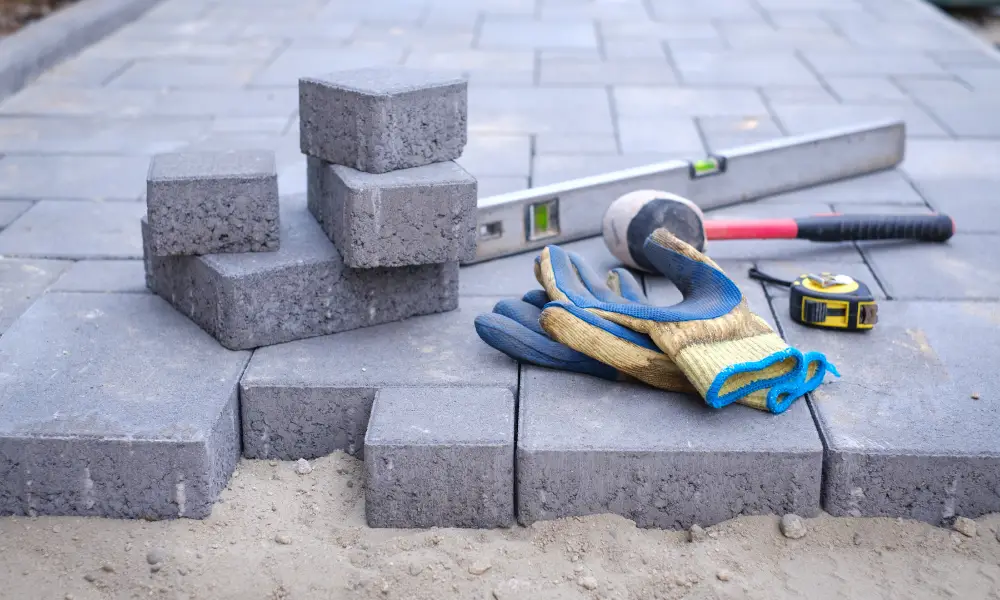You’re about to embark on a hardscaping project, and you’ve chosen pavers as your material of choice for a good reason. Their durability, versatility, and aesthetic appeal can add value and charm to any outdoor space.
But before you start laying those pavers, there’s a crucial decision you need to make: what type of sand will you use?
This might seem like a minor detail but rest assured, it plays an integral role in the success of your project.
Choosing the right sand can mean the difference between a sturdy, long-lasting result or a crumbling disappointment over time. Apart from providing structural support for your pavers, the sand also fills up spaces in between them, thus preventing weed growth and deterring pests.
It’s not just about picking any kind of sand either; different types offer unique benefits depending on your specific needs and environment.
Whether it be concrete sand with its superior drainage capabilities or polymeric sand known for exceptional strength and resilience under extreme conditions – making an informed choice is pivotal to achieving desired outcomes.
Understanding the Importance of Choosing the Right Materials

You’re building a beautiful patio or driveway, so you’ve got to understand it’s not just about aesthetics – choosing the right sand for your pavers is like picking the perfect foundation for your dream house.
The type of sand you use can significantly impact two essential factors: Material Durability and Environmental Impact.
When discussing Material Durability, remember that good-quality bedding sand provides a smooth surface for your pavers to lay on, reducing friction and preventing movement over time. This protection extends the life of your pavers by minimizing chipping and cracking.
Moreover, using improper or low-quality sand can lead to uneven surfaces, water pooling, and, ultimately, premature erosion of your hard work. Hence, investing in high-grade material ensures durability.
As for the Environmental Impact factor, consider that some types of sand are more sustainable than others.
For instance, river sand is often dredged from delicate ecosystems causing irreversible damage, while manufactured sand (M-sand) is an eco-friendly alternative made from crushed rock – offering similar benefits without harming our environment.
Therefore, before finalizing any decision regarding materials choice for paving projects, remember – it’s not only about creating a stunning appearance but also contributing towards a more sustainable future!
The Benefits of Concrete Sand

Like a sturdy anchor in a stormy sea, concrete sand ensures your outdoor space remains solid and unyielding under the whims of weather and time. This exceptional type of sand is often used as the base material for pavers due to its superior quality.
It’s a finely crushed stone that forms a hard, tight bond when compacted with water and cement – an attribute that significantly enhances Concrete Durability.
The Sand Quality is crucial for paver installations since it directly impacts the longevity and stability of your project. Concrete sand possesses rougher, larger grains than play or masonry sand, which allows it to drain well and resist compaction.
This means no matter how much foot traffic your pavers endure or what Mother Nature throws at them; they’ll remain steadfastly in place without shifting or becoming uneven over time.
Concrete sand is also extremely versatile, making it suitable for various applications beyond just paver bases, like mixing concrete and filling gaps between stones. Plus, its high silica content prevents weeds from sprouting between your pavers.
With these benefits in mind, you can see why concrete sand stands out as the optimal choice for paving jobs – ensuring not only aesthetic appeal but also long-lasting resilience against wear and tear.
An Overview of Polymeric Sand

Switching gears, let’s delve into the world of polymeric sand – a game-changer that’s revolutionizing how we approach paving projects.
Polymeric sand is a unique blend of fine sands and polymer additives. When mixed with water, these polymers activate and bind the sand particles together, creating a mighty adhesive that resists washout from rain or snow.
With its superior interlock capability, it provides an immensely durable joint between pavers to prevent shifting and maintain structural integrity over time. This characteristic gives rise to what you’d call ‘Polymeric durability,’ making it an ideal choice for heavy-traffic areas.
With regard to aesthetics, polymeric sand doesn’t lag behind, either. One standout feature of this type of sand is its color variations. These allow you to match the filler material closely with your paver colors creating a more unified or contrasting look depending on your preference.
The coloring in polymeric sand is stable and resistant to fading under UV radiation, ensuring long-lasting visual appeal alongside functional efficiency.
While there are many types of sand available for paving purposes, none quite compare to the features offered by polymeric sand. Its robustness, coupled with aesthetic flexibility, makes it an exceptional choice for both residential and commercial paving projects alike.
Remember, though, that proper installation is critical, as improper use could lead to hazing on your pavers or even compromise the binding effect of the polymers over time.
The Role of Regular Masonry Sand

Now, let’s move on to regular masonry sand and its role in the world of paving.
Masonry sand is a key component when it comes to constructing pavers. It plays an indispensable part in providing stability and enhancing overall masonry durability.
This type of sand is finely graded, meaning it has been sifted through various screen sizes to ensure a consistent texture that can fill gaps between pavers effectively.
With this uniform consistency, it facilitates better compaction and helps maintain alignment, thereby serving as an ideal base for your paver project.
Masonry sand isn’t just about technical benefits; it also brings aesthetic appeal to your paving projects. Sand color variations are one of the interesting features you could leverage for visual interest.
Available in different shades ranging from white and beige to tan based on where it’s sourced from, masonry sand can complement or contrast with your chosen pavers’ color scheme for a more customized finish. Its fine texture also contributes subtly to the look and feel of the finished pavement surface.
So why should you consider regular masonry sand for your next paver project? Beyond its basic function as bedding material – providing a stable foundation – it lends itself well to joint-filling tasks too!
The fine grains fit snugly into cracks and crevices between the bricks or stones used in paving, acting like the glue that holds everything together tightly while still allowing some flexibility for movement without cracking or shifting out of place.
Choosing masonry sand not only guarantees robust construction but also delivers on aesthetics thanks to its varied colors and smooth texture!
Tips for Successfully Using Sand in Your Hardscaping Project

You’re probably wondering how to get the most out of your hardscaping project, right?
Well, according to a recent survey by the National Association of Landscape Professionals, over 80% of homeowners who used materials like masonry sand reported increased satisfaction with their outdoor spaces.
One reason for this high level of satisfaction is likely due to the proper implementation of sanding techniques during paver installation. When done correctly, these techniques can drastically improve the longevity and aesthetic appeal of your hardscapes.
Sanding is an integral part of setting up pavers correctly. First off, you need to lay down a bed of coarse-grained sand. This provides a solid base for your pavers and helps prevent shifting over time.
Once the pavers are installed on top of this layer, you’ll want to apply another layer of finer sand (often referred to as ‘polymeric’ or ‘joint’ sand) into the gaps between each unit. This step is crucial as it locks in your pavers and prevents them from moving around while also deterring weed growth and pests.
Remember that using too much or too little sand can lead to problems down the line, such as sinking or shifting pavers.
To avoid these issues, consult with a professional landscaper or contractor who has experience in hardscaping projects and understands how different types of sand interact with various paving materials and weather conditions.
Also, bear in mind that ongoing maintenance – including regular re-sanding – will ensure that your beautiful new patio or walkway stays just as perfect as when it was first installed!
Conclusion
In the end, choosing the right sand for your pavers is like selecting the perfect ingredients for a recipe.
Just as you’d want fresh herbs over dried ones to enhance your dish’s flavor, so too would you prefer polymeric or concrete sand to boost your project’s durability and appeal.
Don’t underestimate this seemingly minor detail.
Much like that pinch of salt can transform a bland meal into a culinary delight, the right sand can significantly improve your hardscaping masterpiece.





